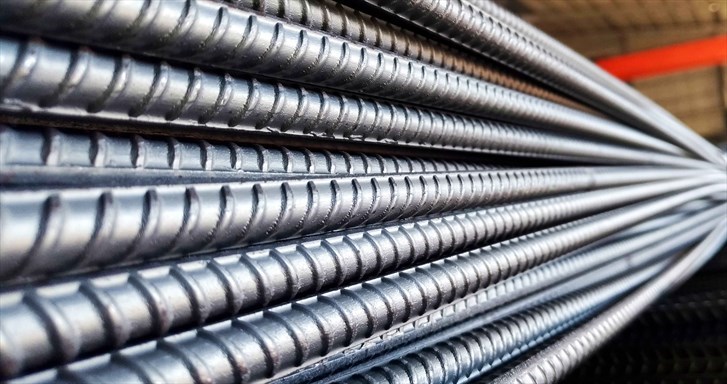Steel export value likely to drop 4% under CBAM impact
The World Trade Organisation (WTO) estimated that steel export value may drop by 4% under the impact of the EU Carbon Border Adjustment Mechanism (CBAM). A drop in demand will lead to a reduction of about 0.8% in output.
09/02/2024 13:17
 Steel consumption is forecast to recover in 2024 (Photo: VietnamPlus)
Steel consumption is forecast to recover in 2024 (Photo: VietnamPlus)
Hanoi, (VNA) - The World Trade Organisation (WTO) estimated that steel export value may drop by 4% under the impact of the EU Carbon Border Adjustment Mechanism (CBAM). A drop in demand will lead to a reduction of about 0.8% in output.
On the occasion of the Lunar New Year of Giap Thin, Pham Cong Thao, Deputy General Director of Vietnam Steel Corporation (VNSteel) shared with VietnamPlus his views on Vietnam's steel industry in 2024, as well as solutions for the industry to catch up with new trends of the world economy.
Weak purchasing power hinders recovery of steel enterprises
Reporter: Looking back on the past year, could you please tell us about the advantages and disadvantages of Vietnam's steel industry?
Pham Cong Thao: It can be seen that in 2023, Vietnam managed to maintain macroeconomic and social stability in the context of complicated geopolitical and economic fluctuations in the world.
Notably, the Government continued to actively implement many policies to remove difficulties for production and business, creating favourable conditions to support businesses to gradually recover and overcome difficulties. The State Bank of Vietnam has loosened monetary policy and reduced interest rates many times to support economic growth.
The existing FTAs between Vietnam and its major partners such as the European and American markets continued to have positive impacts on the country’s trade, investment and especially exports.
Despite this, 2023 continued to be a particularly difficult year for Vietnam's steel industry. Low demand and weak purchasing power hindered the recovery of steel enterprises. The real estate market, for example, the main output of the domestic steel market remained gloomy, due to legal obstacles, limited bank credit, and a decline in family incomes. Public investment was mainly focused on highway projects, so there was little demand for steel.
Demand was weak in most regions of the world, and the pressure of supply-demand imbalance increased when cheap Chinese steel flooded the global market. In 2023, China - the world's largest steel producer - exported over 90 million tonnes of steel, an increase of over 36% compared to 2022.
Price competition leaves little room for steel enterprises to improve production and business efficiency. In 2023, the prices of finished steel products decreased faster than the reduction in input material prices due to downward pressure on prices to compete for consumption.
 Pham Cong Thao, Deputy General Director of Vietnam Steel Corporation (Photo: VietnamPlus)
Pham Cong Thao, Deputy General Director of Vietnam Steel Corporation (Photo: VietnamPlus)
According to data from the Vietnam Steel Association (VSA), in 2023, production of all kinds of steel fell by 7% year on year and sales decreased by 5.3%, of which domestic consumption dropped by 15.6%. Exports grew by 29.1% mainly from increases in hot-rolled coil (HRC) export of Hoa Phat and Formosa. Exports of construction steel decreased by 21.1% and cold-rolled coil reduced by 5.5%.
Reporter: What do you think about the pressure on the steel industry in the face of new EU regulations and major export markets of Vietnamese steel?
Pham Cong Thao: After the Vietnam-EU Free Trade Agreement (EVFTA) came into effect in 2020, Vietnam's steel industry has continuously expanded its export market share in the EU, which is now one of the main export markets of Vietnam's steel.
According to customs data, in 2023, Vietnam exported over 2.5 million tonnes of steel products to this market, doubling the figure of 2022. Steel exports to the EU market accounted for 23% of Vietnam's total steel exports in 2023. However, from mid-2023, exports to the EU market faced two major barriers: safeguard measures and carbon border adjustment mechanism (CBAM).
The first hurdle comes from safeguard measures targeting imported steel. This is a new EU regulation, taking effect from July 1, 2023. It maintains safeguard measures for steel imported into the EU until June 30, 2024. For Vietnam to be exempt from safeguard duties, it has to maintain the proportion of exports at below 3% of the total EU import turnover for each type of product. If the quota is exceeded, the import tax payable for the excess is 25%.
The second hurdle is the CBAM, which aims to levy a carbon tax on all goods imported into EU markets, based on the intensity of greenhouse gas emissions in the host country's production process. Currently, this mechanism is in phase 1 when exporting enterprises, including steel enterprises, must declare emission levels.
When the CBAM mechanism enters the next stage, steel enterprises in Vietnam are required to buy CBAM emission certificates from 2026. This will raise costs and reduce competitiveness if producers do not work to reduce emissions during production.
 Export products bound for EU of SSSC (Photo: SSSC)
Export products bound for EU of SSSC (Photo: SSSC)
Overall, Vietnam's steel export market has been and will be affected by protectionism and carbon emission requirements. Since 2004, there have been more than 70 investigative cases affecting steel exports from Vietnam in connection with anti-dumping, anti-subsidy, and anti-tax evasion.
To prepare to meet CBAM's emission requirements, in recent years, the VSA has organized many seminars, regularly providing updates to member enterprises on CBAM's policies and requirements for imported products. Representatives of State agencies such as the Ministry of Industry and Trade and the Ministry of Natural Resources & Environment attend those seminars to understand the situation and develop policies to support the green transition process of the steel industry.
Competition to grow
Reporter: According to experts, participation in free trade agreements has created many opportunities for the export sector, but in the opposite direction, the competition in the domestic market is also growing fiercer. What is your assessment for the steel industry?
Pham Cong Thao: That’s right, competition in terms of domestic steel prices has, and will become fiercer due to the production capacity of many products far exceeding domestic demand. In addition, the domestic market is under greater pressure from imported steel, especially steel of Chinese and ASEAN origin.
Due to highly competitive pressure, for many years, most domestic steel enterprises have not operated at their full design capacity. Considering the industry, the production of construction steel, galvanized steel and steel pipes is less than 60% of the designed capacity. This is a waste of economic resources as well as a loss for manufacturers. There is very little profit from each tonne of steel produced, which affects the development of steel enterprises and Vietnam's steel industry in general.
Strategic competition between major countries is getting fiercer, uncertainty is increasing, global economic growth recovery is still slow and difficult. There are many potential risks regarding energy, disruption of the supply chain of input materials, political tensions.
The recovery of the steel industry may be more long-term, expected to be more obvious in the last 6 months of 2024 when the bottlenecks of the real estate industry in Vietnam and China are gradually removed.
In addition, domestic steel enterprises continue to face many difficulties in production and business such as the high price of energy, living, and transportation costs. Electricity prices are also expected to continue to increase. Along with that, the exchange rate risk may adversely affect the import cost of raw materials and fuel.
Reporter: In order to help the steel industry improve competitiveness and expand exports, what policies do you think the State needs to issue to support steel enterprises?
Pham Cong Thao: According to the forecast of the World Steel Association, the demand for finished steel products in 2024 will grow by 1.9% compared to 2023. In which, steel demand will increase by 5.7% in the European region (this is also one of the largest steel export markets of Vietnam), and 5.2% in the ASEAN-5 region.
In Vietnam, the VSA forecast that the steel industry is likely to recover weakly in 2024 due to outstanding difficulties in the real estate market. Steel consumption is forecast to increase by 7% to 21.7 million tonnes, and output could reach nearly 29 million tonnes, up 7% from 2023.
In general, VNSteel held that the steel market in 2024 will continue to face more difficulties and challenges than advantages in the context of weak world economic growth forecast. Domestic steel demand in 2024 will recover, but the level of recovery is weak and unlikely to return to the output level as before the COVID-19 pandemic.
The steel corporation proposed that the Government continue to have policies to support enterprises in trade remedies to prevent cheap and poor-quality steel from affecting the market, businesses, and domestic consumers.
 Vietnam’s steel industry could be affected by CBAM
Vietnam’s steel industry could be affected by CBAM
In addition, the Government should define a strategic orientation for the steel industry to develop sustainably. Also, they should take measures and provide financial support to encourage steel manufacturers to upgrade production techniques to reduce energy consumption and carbon emissions. A gradual phase out of inefficient and outdated production technology is also important.
To serve industrialisation and modernisation in the new development period of the country, Vietnam needs to have policy orientations to master the production technology of basic processed steel products, step by step promote the production of special-grade steel and high-quality alloys to serve the domestic mechanical and manufacturing-processing sectors and later for export.
In addition, it is necessary to have preferential policies on land, infrastructure, science and technology and human resource training to encourage and promote hi-tech steel projects. It is also necessary to promote advanced, modern, energy-saving, high productivity and environmentally friendly technology and equipment.
Reporter: Thank you./.
VNA (en.vietnamplus.vn)








